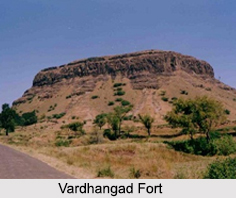 Vardhangad Fort is a famous fort in Satara district of Maharashtra. The fort lies on the Bhadle-Kundla spur of the Mahadev range. It is located at the boundary between the Koregaon and Khatav Talukas. It was used as an outpost guarding the east frontier of his newly acquired territory. The fort was vulnerable to attacks from the adjacent hills of Lalgun and Rameshwar.
Vardhangad Fort is a famous fort in Satara district of Maharashtra. The fort lies on the Bhadle-Kundla spur of the Mahadev range. It is located at the boundary between the Koregaon and Khatav Talukas. It was used as an outpost guarding the east frontier of his newly acquired territory. The fort was vulnerable to attacks from the adjacent hills of Lalgun and Rameshwar.
History of Vardhangad Fort
The construction of the fort was undertaken in 1673 by Chhatrapati Shivaji and was finished in 1674. In 1800, the fort was invested by Mahadji Shinde"s force with 25,000 men. In 1805, the fort was attacked by Fattesingh Mane. In 1807, after the battle of Vasantgad, the fort was then surrendered to Bapu Gokhale. He administered it for 5 years till 1811 when the Peshwa took charge of it.
Structure of Vardhangad Fort
Vardhangad Fort is a round-topped hill rising about 900 feet above the plain. After crossing the gate, a little further up one comes across a small temple of Mahadev which is in good condition. Near the temple is a banyan tree. To the south of the temple are two ponds. There is a temple of Goddess Vardhinidevi on the left side of the Mahadev temple. It is believed that, there is a tunnel leading to Mahimangad Fort. The door of the tunnel is now covered with prickly pear and stones. The fort sloping all-round from the sides to the top is round at the pinnacle, and covers about 20 acres. On the east is a hollow, where there are two ponds and the site of the garrison"s quarters, now thickly covered with prickly pear and the buildings are in ruins. Only two small guns remain among the rubbish. The walls with parapet vary from 10 to 15 feet on the outside, and follow the contour of the ridge. The hollows are being filled up with strong masonry. They are about 16 and half feet thick, with a parapet and is 2 feet high inside. The height is generally about 6 feet from the ground close under them. The masonry of the walls is mostly small and put together with mortar only in a few places. The fort wall has fallen down at a number of places. On the northern side is an empty pond.
Visiting Information of Vardhangad Fort
The ascent to the fort is from a hamlet at its foot on the Khatav side. This is easily reached from the Satara-Pandharpur road, which winds up the southern slope of the fort hill to a hill close to the fort hamlet. The approach to the fort can be made also from the village Panchganiwadi. Both ways are easy. The top of the fort can be reached within 15 to 20 minutes. The path from the hamlet takes about half an hour to ascend with ease and goes diagonally up the south slope, till it reaches the middle of the south side where lies the only gateway to be reached by a turn to the south-west.



















